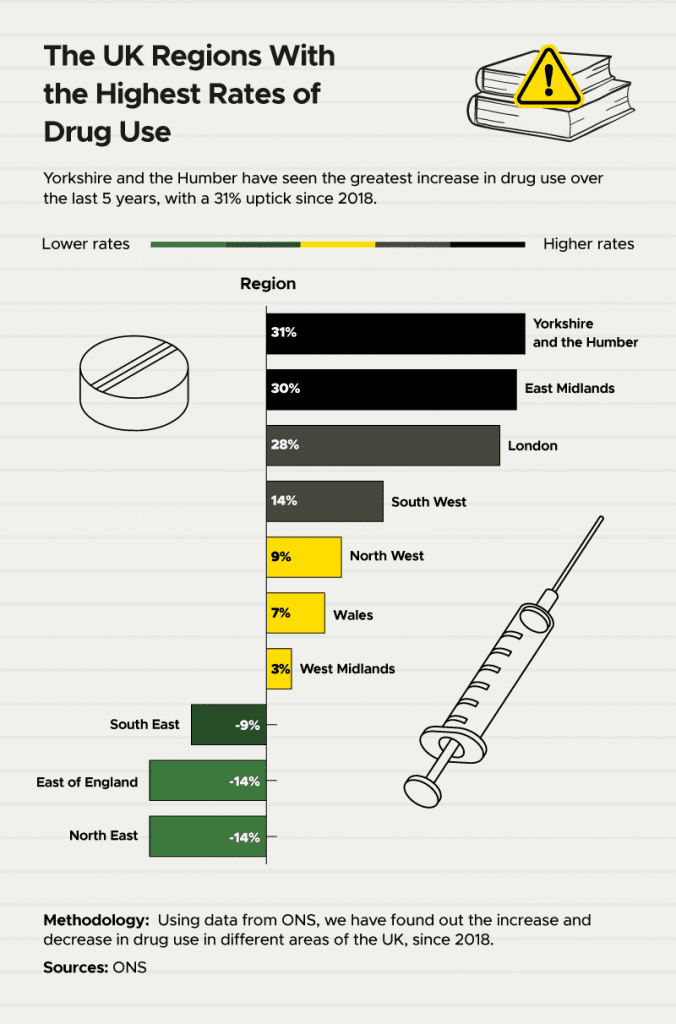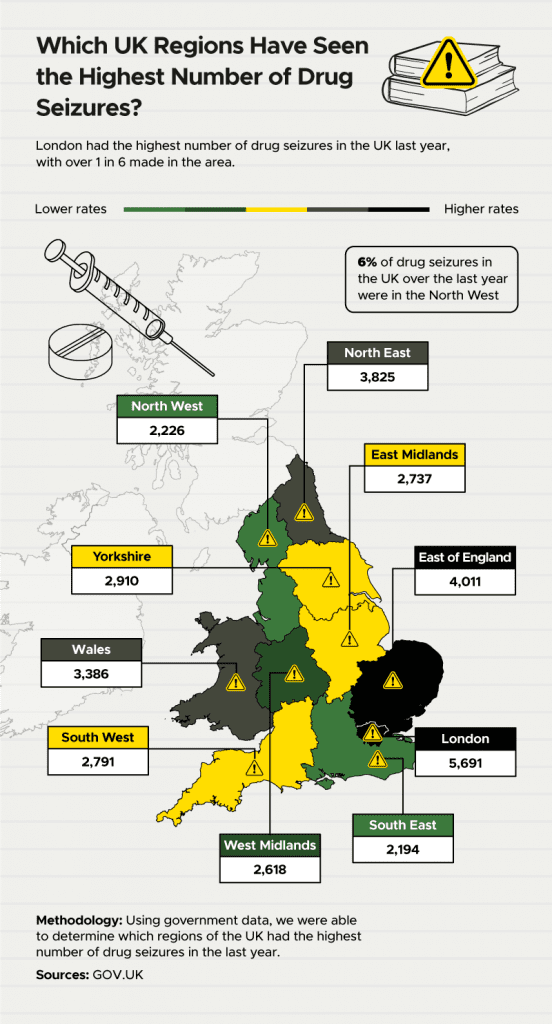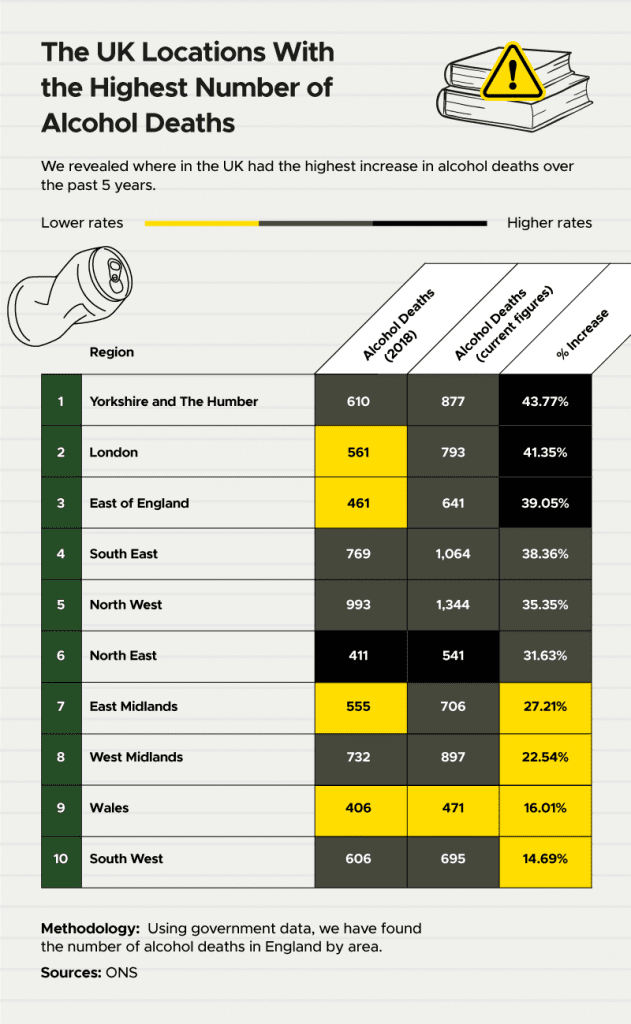UK Drug Addiction Report 2023

on 26 May 2023
What’s included?
- Introduction
- How have alcohol dependency rates in the UK changed?
- North West Locations with the Highest Rate of Alcohol Dependency
- The UK Regions with the Highest Rates of Drug Use
- Which UK regions have seen the highest number of drug seizures?
- How Have Alcohol-Related Hospital Admissions in the North West Shifted?
- The UK Locations With The Highest Number of Alcohol Deaths
- Methodology
In the UK, it is a truth commonly acknowledged that alcohol and drug consumption is a huge problem – and it isn’t just people who live here that notice it. As a 2021 Vice article reported, many people who visit the concrete streets of our great nation are ‘shocked’ by how ‘integral’ drinking culture is to the Brits. The article goes on to suggest that ‘blackouts’ (drinking so much that you remember nothing the next day) are seen as totally normal, alongside the habit of ‘drinking at lunch’.
After taking this in, it is perhaps no shock that, according to one study, 71.2% of UK adults admitted to consuming alcohol at least once a week. Worryingly, the issue is also impacting younger generations, with a recent survey also highlighting that 11,326 of people under the age of 18 had been in contact with alcohol and drug services between April 2021 and March 2022.
Bearing these figures in mind, it may be unsurprising to learn that alcohol is now recognised as the fifth biggest cause of death, ill health and disability by Public Health England. What’s more, in 2022 government research found that the UK is among the top European countries most affected by drug issues.
As the ongoing cost of living crisis continues to impact nearly all aspects of daily life in the UK, many households are feeling the pressure and stress that comes with the responsibility of paying bills and maintaining a certain standard of living. Worryingly, a 2021 study we conducted shone a light on how over half of UK drinkers (56%) admitted to reaching for alcohol in order to relax. There are many other factors that influence how certain areas of the country consume alcohol and drugs, but what effect do these issues have on addiction levels?
Our team of specialists have taken a deep dive into the most recent statistics on drug and alcohol use across the UK, to reveal how the misuse of substances can impact people’s lives. We have also carried out some specific research into the drug and alcohol issues people are currently facing in the North West of England, to reveal some of the regional differences that determine the consequences of addiction.
How have alcohol dependency rates in the UK changed?

The UK drinking culture is considered by many as a significant part of everyday life. Whether in the form of after-work drinks to unwind after a busy week or a weekend trip to a local bar or nightclub, the chances of someone’s social calendar revolving around alcohol consumption are relatively high.
However, for many individuals, this laidback and blasé attitude towards drinking either regularly or to excess can often lead to problematic consequences.
Within our report, it emerged that the North East town of Darlington has experienced the highest increase in alcohol dependency. With a population of 108,222, it saw an alarming 427.68% increase in dependency rates, with a worrying 267 alcohol-dependent individuals within the town living with, and caring for minors.
England’s capital city of London has also experienced a significant rise in reported cases of alcoholism. The bustling city emerged as the second most reliant on alcohol, with a 59.46% increase in dependency since 2018.
Further south, the port city of Southampton emerged as the location with the third highest increase in alcohol dependency rates across the UK. The staggering rise of 32.22% suggests that many living in the area could have a problematic relationship with alcohol.
North West Locations with the Highest Rate of Alcohol Dependency

The North West region has some of the most alarming figures when it comes to alcohol dependency, with the issue affecting a number of its larger cities and towns. The issue is even impacting a concerning number of children between the ages of 14 to 17, with 52% of this age demographic admitting they’ve already started to consume alcohol.
Since 2018, the city of Salford has witnessed the highest increase in alcohol dependency, with a concerning 7.7% uptick. The number of dependent drinkers in Manchester is continuing to rise and sits 70% higher than the national rate.
Another Manchester-based area revealed as having an increasing issue with alcohol dependency among residents is Oldham, which has seen a 6.53% rise.
The city of Liverpool joins Manchester as one of the most alcohol-dependent cities with a 5.83% increase. The Council’s 2021 Public Health Annual Report highlighted that during Covid-19, 12% of men and 11% of women increased the amount of alcohol they were drinking by as much as 4 x more per week.

Founder and Chief Executive at Delamere, Martin Preston, comments on why the North West may be struggling with alcohol dependency more than other regions in the UK:
“The North West’s dependence on alcohol can be attributed to a number of circumstantial elements:
“The first being that the help and services available for those struggling with alcohol addiction is massively lacking, due to underfunding and cuts. The services that are available in these areas also have to prioritise the long-term most critical users, meaning that the capacity and expertise available are full and not accessible to those with less serious or more recently apparent issues.
“Other socioeconomic reasons behind why alcoholism is rife in the North West may lie in the fact that these areas have higher levels of social deprivation, and alcohol is more easily accessible due to the vast number of off-licences.
“In order for those living in the North West to seek the help and treatment they need, and for alcohol dependency figures to decrease, this region would require government support in a number of areas. This includes investing in education surrounding alcohol use, as well as investment in more prevention and treatment programmes. Alcohol’s affordability and availability would also have to be better regulated to prevent alcohol dependency.
The UK Regions with the Highest Rates of Drug Use

Substance use across the UK has continued to increase over the last 5 years, with Covid-19 and the after effects of the pandemic contributing to a significant spike in the figures from 2020 onwards.
Drug usage – including everything from class C drugs like steroids and tranquillizers, to harder class A substances like heroin, cocaine and ecstasy – is still worryingly widespread across the UK, with the most affected regions emerging as Yorkshire and The Humber, the East Midlands and London.
The results of our report identify Yorkshire and the Humber as the region with the highest rates of drug use. The area has seen a 31% increase in users over the last 5 years, suggesting that those living in the region require a drastic need for change and support.
Worryingly, the East Midlands only narrowly avoided being labelled the region with the highest drug use. The area, with a large population of 4.811 million, still had an alarming 30% increase in drug use over the last 5 years.
Increased substance abuse is also extremely prevalent within the south, with London witnessing the third biggest increase in users from 2019 to date, at 28%. When it came to consumption levels, one study revealed that those living in the capital were consuming on average 23kg of class-A drugs every day.

Catherine Carney, Delamere’s psychiatrist and addiction specialist, addresses why substance abuse has continued to increase over the last 5 years:
“As a result of the pandemic, the last few years have been a period of extreme stress and uncertainty for the world, and many individuals have turned to substances as a means of release or escape.
“The rise in people using drugs during Covid-19 could have likely resulted from the knock-on effects of the pandemic. This included increased free time due to a large percentage of individuals being placed on furlough, as well as boredom and isolation through social restrictions. Furthermore, the stressful and emotional pressures of life-changing events like job losses or the death of loved ones – which became much more prevalent during this time frame.
“For those already battling with addiction or in recovery, this period proved detrimental due to a lack of access to medication, leaving them in a vulnerable position.
“So why has the number of substance users continued to rise post-pandemic? This can be attributed to individuals struggling to readapt to everyday life following the lockdown.
“Whether this meant managing the daily stresses of returning back to work, dealing with the impacts of the pandemic on their mental health, learning to feel safe again in a post-Covid-19- world, or simply finding a healthy balance when it came to engaging in alcohol-related socialising again.”
Which UK regions have seen the highest number of drug seizures?

The UK is experiencing an increase in police and border forces seizing drugs that are either entering Britain or have already made their way into the country, in the battle to prevent drug distribution in the UK.
In March 2022, 188,929 drug seizures were made in England and Wales, however, some regions in particular had a more significant number than others.
Data revealed London is the region that had the highest number of drug seizures in the last year, with 5,691. This figure highlights the sheer volume of substances circulating in the area, including notable imports via the region’s major airports of Heathrow and Gatwick.
The East of England – home to towns and cities like Cambridge, Bedford, Norwich, Luton, Chelmsford and Peterborough – has seen the second sharpest increase in drug seizures, with a shocking 4,011 in the last year alone.
Revealed as the region with the third highest figure of drug seizures is the North East. The region – made up of the major cities Durham, Newcastle upon Tyne, and Sutherland – experienced 3,825 drug seizures in the last year.
The North West made up 6% of the overall drug seizure in the UK over the last year, with Manchester, Liverpool, Chester, Carlisle, Lancaster, Preston and Salford among major cities contributing to this figure.
How Have Alcohol-Related Hospital Admissions in the North West Shifted?

Since 2018, alcohol-related hospital admissions across the UK have decreased significantly, with some areas, including Trafford, West Lancashire and Oldham, dropping at a notably rapid rate.
Trafford in Greater Manchester saw the biggest decline in alcohol-related hospital admissions over the last 5 years. The decrease of a significant 81.02% will have an extremely positive impact, relieving some of the pressure and stress on hospitals in the Trafford area.
West Lancashire was revealed as the area with the second-largest decline in people being admitted to hospital as a result of alcohol use. Decreasing by 80.53%, this significant change shows a positive movement for those living in the area.
Oldham, Greater Manchester was also among the locations that saw a large decrease in alcohol-related admissions over the last 5 years. The town had a notable fall in admissions, with a remarkable 80.39%.
Martin Preston, Founder and Chief Executive at Delamere, explains how the Covid-19 pandemic contributed to these findings:
“There are a number of reasons that alcohol-related hospital admissions have decreased as a result of the pandemic, and whilst some reasons are positive, others are equally negative.
“It could be argued that these figures indicate that people in the North West were drinking in the safety of their own homes during the pandemic due to bars and pubs being shut, or focusing on their health and well-being by cutting out drinking altogether. This, in turn, may mean that individuals were less likely to encounter the dangers that can occur from drinking in public places, including injuries from physical fights, road incidents and physical injuries from falls.
“However, the more negative effect of the pandemic was that hospitals were offering limited services to individuals, and that those suffering and seeking help for their alcoholism during the pandemic and since, simply haven’t been able to access it. Worryingly, alcohol deaths increased in the year 2020, which indicates that the unfortunate consequences of those struggling to source help were fatal.”
The UK Locations With The Highest Number of Alcohol Deaths

Casual drinking at home increased dramatically during the pandemic, with many people developing unhealthy and dependent relationships with alcohol. This seems to have led to the rise of alcohol-related deaths, with UK deaths standing at 8,974 in the first year of the pandemic (2020) and 9,641 in the second year (2021), up by 2,076 from 2019.
Our research shows Yorkshire and The Humber is the region with the highest number of alcohol-related deaths. The area has seen a 43.77% increase over the last 5 years with the current number of deaths at a worrying 877. Leeds, one of the major cities in the region of Yorkshire and The Humber, saw 113 people die from alcohol-related causes during the first year of the Covid-19 pandemic alone.
The region of London has the second-highest number of deaths as a result of alcohol use, with a 41.35% increase since 2018. The current alcohol-related death rate stands at 793, indicating that many living in the area have a troublesome relationship with drinking.
Alcoholism in the East of England is also rife, as the region has experienced a 39.05% increase in deaths related to alcohol. With alcohol deaths currently standing at 641, those living in these eastern cities and towns require a drastic change of lifestyle.
Methodology:
- How have alcohol dependency rates in the UK changed?
Using government data, we have found how much alcohol dependency rates have changed across the UK since 2018.
- The North West locations with the highest rates of alcohol dependency
Using data from gov.uk, we revealed which locations in the North West had seen the biggest increase in alcohol dependency rates since 2018.
- The UK Regions with the Highest Rates of Drug Use
Taking figures from ONS, we found how much drug use has increased and decreased in each region of the UK since 2018.
- Which UK regions have seen the highest number of drug seizures?
Using government data, we found which regions of the UK have seen the highest number of drug seizures in the last year.
- How Have Alcohol-Related Hospital Admissions in the North West Shifted?
Using the most recent figures published by gov.uk we found which areas of the North West saw the biggest change in alcohol-related hospital admissions, since 2018.
- The UK Locations With The Highest Number of Alcohol Deaths
Taking data from the ONS, we were able to determine which regions of the UK had the highest number of alcohol-related deaths since 2018.

About the author: Martin Preston
Martin created Delamere in order to provide exemplary care in first class facilities. Find out more about Martin on our team page.
RECENT POSTS
The Power of Reaching out a HandFrom sobriety to quality of life: Revisiting recovery outcome measures
The role of alcohol in UK culture, and how to break free
Holistic diet tips to balance energy and mood
CATEGORIES
-
Addiction Recovery
Addiction Reports
Alcohol Addiction
Burnout
Delamere
Digital Addiction
Drug Addiction
Holistic Programmes
Other Behaviours
Prescription Drug Addiction
Rehab
ARCHIVES
- December 2025
- November 2025
- October 2025
- September 2025
- August 2025
- July 2025
- June 2025
- May 2025
- April 2025
- March 2025
- February 2025
- January 2025






